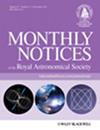The Giant Molecular Cloud G148.24+00.41: Gas Properties, Kinematics, and Cluster Formation at the Nexus of Filamentary Flows
IF 4.7
3区 物理与天体物理
Q1 ASTRONOMY & ASTROPHYSICS
引用次数: 0
Abstract
Filamentary flows toward the centre of molecular clouds have been recognized as a crucial process in the formation and evolution of stellar clusters. In this paper, we present a comprehensive observational study that investigates the gas properties and kinematics of the Giant Molecular Cloud G148.24+00.41 using the observations of CO (1-0) isotopologues. We find that the cloud is massive (105 M⊙) and is one of the most massive clouds of the outer Galaxy. We identified six likely velocity coherent filaments in the cloud having length, width, and mass in the range of 14−38 pc, 2.5−4.2 pc, and (1.3−6.9) × 103 M⊙, respectively. We find that the filaments are converging towards the central area of the cloud, and the longitudinal accretion flows along the filaments are in the range of ∼ 26−264 M⊙ Myr−1. The cloud has fragmented into 7 clumps having mass in the range of ∼ 260−2100 M⊙ and average size around ∼ 1.4 pc, out of which the most massive clump is located at the hub of the filamentary structures, near the geometric centre of the cloud. Three filaments are found to be directly connected to the massive clump and transferring matter at a rate of ∼ 675 M⊙ Myr−1. The clump hosts a near-infrared cluster. Our results show that large-scale filamentary accretion flows towards the central region of the collapsing cloud is an important mechanism for supplying the matter necessary to form the central high-mass clump and subsequent stellar cluster.巨型分子云 G148.24+00.41:丝状流交汇处的气体性质、运动学和星团形成
在恒星簇的形成和演化过程中,向分子云中心流动的丝状气流被认为是一个至关重要的过程。在本文中,我们利用 CO (1-0) 同素异形体的观测数据,对巨分子云 G148.24+00.41 的气体性质和运动学进行了全面的观测研究。我们发现该云的质量很大(105 M⊙),是银河系外围质量最大的云之一。我们在云中发现了六条可能的速度相干细丝,其长度、宽度和质量范围分别为 14-38 pc、2.5-4.2 pc 和 (1.3-6.9) × 103 M⊙。我们发现云丝向云的中心区域汇聚,沿云丝的纵向吸积流范围为 ∼ 26-264 M⊙ Myr-1。云团分裂成 7 个团块,质量在 260-2100 M⊙之间,平均大小约为 1.4 pc,其中质量最大的团块位于丝状结构的中心,靠近云团的几何中心。发现有三条丝状结构与大质量团块直接相连,并以 ∼ 675 M⊙ Myr-1 的速度传输物质。这个云团还承载着一个近红外星团。我们的研究结果表明,向坍缩云团中心区域的大尺度丝状吸积流是为形成中心高质云团和随后的恒星簇提供必要物质的重要机制。
本文章由计算机程序翻译,如有差异,请以英文原文为准。
求助全文
约1分钟内获得全文
求助全文
来源期刊

Monthly Notices of the Royal Astronomical Society
ASTRONOMY & ASTROPHYSICS-
CiteScore
9.10
自引率
37.50%
发文量
3198
审稿时长
3 months
期刊介绍:
Monthly Notices of the Royal Astronomical Society is one of the world''s leading primary research journals in astronomy and astrophysics, as well as one of the longest established. It publishes the results of original research in positional and dynamical astronomy, astrophysics, radio astronomy, cosmology, space research and the design of astronomical instruments.
 求助内容:
求助内容: 应助结果提醒方式:
应助结果提醒方式:


